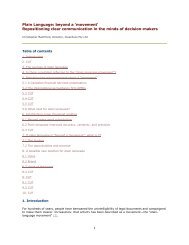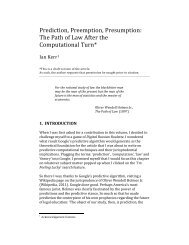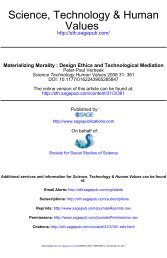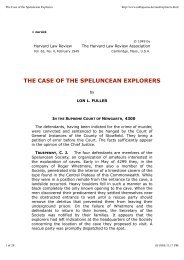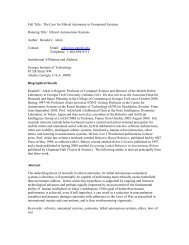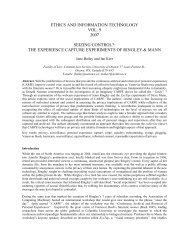'Asimov's Laws of Robotics' - the Laws of Robotics 2013
'Asimov's Laws of Robotics' - the Laws of Robotics 2013
'Asimov's Laws of Robotics' - the Laws of Robotics 2013
- No tags were found...
Create successful ePaper yourself
Turn your PDF publications into a flip-book with our unique Google optimized e-Paper software.
Roger Clarke's <strong>'Asimov's</strong> <strong>Laws</strong> <strong>of</strong> <strong><strong>Robotics</strong>'</strong><strong>2013</strong>-09-03 10:33 AMThe <strong>Laws</strong> <strong>of</strong> <strong>Robotics</strong> designate no particular class <strong>of</strong> humans (not even a robot's owner) as more deserving<strong>of</strong> protection or obedience than ano<strong>the</strong>r. A human might establish such a relationship by command, but <strong>the</strong>laws give such a command no special status: ano<strong>the</strong>r human could <strong>the</strong>refore countermand it. In short, <strong>the</strong>laws reflect <strong>the</strong> humanistic and egalitarian principles that <strong>the</strong>oretically underlie most democratic nations.The laws <strong>the</strong>refore stand in stark contrast to our conventional notions about an information technologyartifact, whose owner is implicitly assumed to be its primary beneficiary. An organization shapes anapplication's design and use for its own benefit. Admittedly, during <strong>the</strong> last decade users have been givengreater consideration in terms <strong>of</strong> both <strong>the</strong> human- machine interface and participation in system development.But that trend has been justified by <strong>the</strong> better returns <strong>the</strong> organization can get from its information technologyinvestment ra<strong>the</strong>r than by any recognition that users are stakeholders with a legitimate voice in decisionmaking. The interests <strong>of</strong> o<strong>the</strong>r affected parties are even less likely to be reflected.In this era <strong>of</strong> powerful information technology, pr<strong>of</strong>essional bodies <strong>of</strong> information technologists need toconsider:identification <strong>of</strong> stakeholders and how <strong>the</strong>y are affected;prior consultation with stakeholders;quality assurance standards for design, manufacture, use, and maintenance;liability for harm resulting from ei<strong>the</strong>r malfunction or use in conformance with <strong>the</strong> designer'sintentions; andcomplaint- handling and dispute- resolution procedures.Once any resulting standards reach a degree <strong>of</strong> maturity, legislatures in <strong>the</strong> many hundreds <strong>of</strong> legaljurisdictions throughout <strong>the</strong> world would probably have to devise enforcement procedures.The interests <strong>of</strong> people affected by modern information technology applications have been gainingrecognition. For example, consumer representatives are now being involved in <strong>the</strong> statement <strong>of</strong> userrequirements and <strong>the</strong> establishment <strong>of</strong> <strong>the</strong> regulatory environment for consumer electronic- funds- transfersystems. This participation may extend to <strong>the</strong> logical design <strong>of</strong> such systems. O<strong>the</strong>r examples are trade- unionnegotiations with employers regarding technology- enforced change, and <strong>the</strong> publication <strong>of</strong> s<strong>of</strong>tware qualityassurancestandards.For large- scale applications <strong>of</strong> information technology, governments have been called upon to applyprocedures like those commonly used in major industrial and social projects. Thus, commitment might haveto be deferred pending dissemination and public discussion <strong>of</strong> independent environmental or social impactstatements. Although organizations that use information technology might see this as interventionism,decision making and approval for major information technology applications may never<strong>the</strong>less become morewidely representative.Closed- system versus open- system thinkingComputer- based systems no longer comprise independent machines each serving a single location. Themarriage <strong>of</strong> computing with telecommunications has produced multicomponent systems designed to supportall elements <strong>of</strong> a widely dispersed organization. Integration hasn't been simply geographic, however. Thepractice <strong>of</strong> information systems has matured since <strong>the</strong> early years when existing manual systems wereautomated largely without procedural change. Developers now seek payback via <strong>the</strong> rationalization <strong>of</strong>http://www.rogerclarke.com/SOS/Asimov.htmlPage 21 <strong>of</strong> 30



